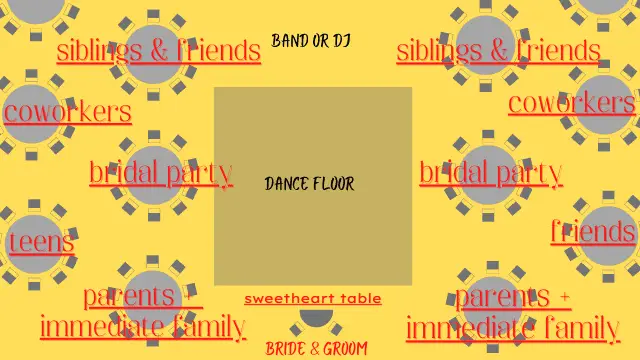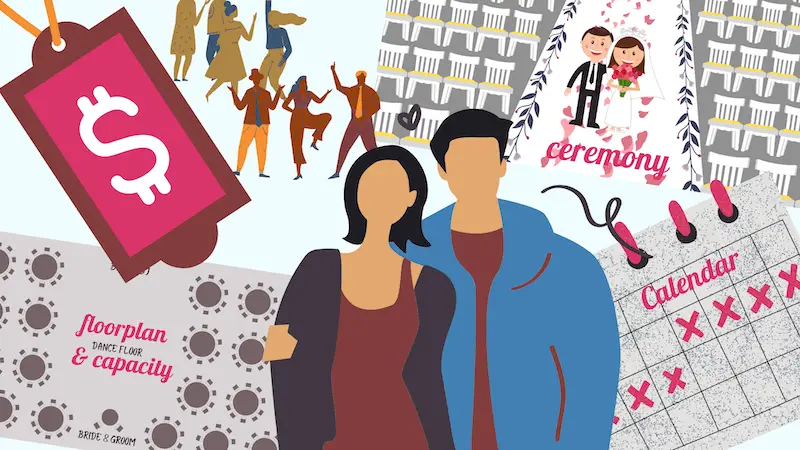Wedding Reception Seating Arrangements Etiquette (Solved)
Planning a wedding reception is an event that requires careful attention to detail.
If you are doing a served, plated formal dinner, this blog post is for you. However, detailed seating arrangements etiquette does not apply to cocktail-reception-style events.
One of the most important aspects of good planning is seating arrangements, which can be difficult if you don’t allocate enough time to work on them.
The number of guests you invite will affect how many tables are needed during dinner and where they should be placed to accommodate them properly.
Planning seating arrangements require great focus. Your guests will need to find their tables easily after the cocktail reception, so the party stays fluid and won’t stall.
After you move them into the ballroom to get your wedding dinner started, you want to make sure your party is off to a great start and guests can continue to enjoy themselves.

Wedding Reception Seating Plans: Why They Are So Important
Wedding reception seating plans can be a headache, and it may seem like the last thing you want to do when planning your wedding.
But seating arrangements etiquette is an integral part of any formal dinner for the following reasons:
- Guests will need to find their tables quickly and easily to keep your timeline intact.
- The sooner guests find their seats, the sooner the waiters can take their orders (i.e., if you have a choice of entrees on your menu).
- If you have a large wedding, a mistake in the seating arrangements can derail the entire beginning of the reception at the affected tables and cause grief for your guests.
- Guests appreciate assigned tables, and it will make things run more smoothly.
The easiest way to manage your seating chart is by prioritizing guests.
For instance, the dearer and more important specific guests are to you, the more it will affect whom you should put close to your table.
One easy way to help organize seating is by grouping your immediate family, starting with your parents being the closest tables to yours.
Make sure that all generations of your family are close and around enough to spend time together.
Assigned Seating vs. Open Seating At Wedding Receptions
If you are hosting a cocktail reception-style wedding with limited seating, this will not apply. In contrast, if you host a formal dinner with plated food, you will need to seat all guests at dinner tables.
- Assigned Seating: Your guests will be given a designated table with a designated chair (indicated by a place card) or just a designated table, and they pick their own chair as they get to their table.
- Open Seating: Tables are unassigned, and your guests will have to hunt for a table for dinner following cocktails. This can lead to confusion and frustration on the side of your guests, and in general, open-seating should be avoided at all costs. In addition, some tables that are set up will not work out, and guests will grab chairs from other tables to add to their dinner tables to accommodate more people randomly.
Assigned Seating Arrangements Etiquette Tips
You want to let your guests know where they are seated during dinner.
To achieve this, you would need an escort card table placed in a prominent area that guests will walk by automatically during the cocktail reception.
The other option would be a seating chart. And again, it would need to be placed with apparent and more prolonged exposure so guests don’t have to search for it.
An excellent place for either the escort card table or seating chart is at the entrance of the cocktail reception space since guests have no other way but to notice it.
You want your guests to get familiar with their table number during the cocktail reception and not find their escort card when you begin to move them into the ballroom. This would bottle-neck the transfer from room to room.
Assigned Seating Has Four Different Types
- Escort Cards only: these individual cards (i.e., little tent cards) will be marked with a table number showing each guest at which table they are seated. You would display the cards in the cocktail reception area for guests to pick up.
- Escort Cards + Place Cards: the Escort Card will let your guests know what tables they are assigned to. In addition, Place Cards are put on each dinner table inside the ballroom at every place setting to mark where each guest is seated at each table.
- Seating Chart + Place Cards: the same principle as 2. Instead of individual escort cards displayed inside the cocktail reception room, you would provide a seating chart (i.e., displayed on an easel or any other fancy form of display).
- Seating Chart only: these can be fanciful, handcrafted charts with your guests’ names listed in alphabetical order (recommended) or by table number (not recommended for large weddings).
Seating charts are notoriously slowing down the process of guests finding their table assignments.
If everyone decides to look at their table number as they are ushered into the ballroom, this area becomes overcrowded and stalls the flow. In addition, getting guests moving from one location to another will take much longer.

Furthermore, guests frequently forget their table numbers rather than having the benefit of an escort card in their pocket for cross-checking.
Because of this, make sure you provide the venue with a few copies of your guest list with names in alphabetical order and table numbers for staff to help guests find their tables.
Your escort cards should always be sorted in alphabetical order by last name!
Using Individual Place Cards For Each Place Setting On Dinner Tables
If you are ready to put extra work into wedding seating etiquette, consider placing individual place cards for each guest on the dinner tables.
This way, guests have an assigned seat at their dinner table and don’t have to compete over it with the other guests as they are grouped around their table.
If you are serving a menu with various entrees, individual place cards are also useful.
The place cards can be customized with little decals to show what entree each guest picked. This will relieve the wait staff to take each guest’s entree order individually and is less interruptive.
The decal could, for example, indicate if a guest selected chicken, beef, fish, vegetarian, gluten-free, or kosher. In addition, you can color code the decals to make it even easier to notice the choice of entree, i.e., yellow for chicken, blue for fish, red for beef, and so on.

The only hurdle is that individual place cards are a lot of work, and there is no room for errors. Also, a guest without a chair assigned or the wrong card can throw off the entire setup of the dinner table. Or worse, the table is already maxed out and won’t fit another guest.
If a place card is in the wrong position at a table, or if you put the wrong decal on it, or if another table plays a trick by switching out the place cards in between tables, it can raise havoc by triggering a domino effect that is hard to fix.
Ultimately, the best is to have a well-organized team at the venue that can work fast and efficiently, helping you with this job.
Make sure you know exactly who will be putting out the place cards and how each dinner table is organized with a separate seating chart for each dinner table showing exactly which name card is placed at what exact position.
If you don’t have a wedding planner, you would need to find a willing catering manager at the venue to assist you or ask a trustworthy and organized friend to help put out the place cards.
Remember, the place cards are the last thing that goes on the dinner tables only after the tables are set up entirely by the wait staff and florist. It is usually one of the last things to do before guests are ushered into the ballroom and is often done under time constraints.
Pitfalls Of Seating Charts, Escort Cards, And Place Cards
Small print or tiny font, dark ink on a dark background, and fancy undecipherable calligraphy will make it a challenge for guests to find their names.
Likewise, fancy escort card “trees” (tree branches with escort cards attached) can make a lovely display, but they are difficult for your guests to navigate.
Being creative is one thing, but don’t go too crazy with the design and choose functionality over anything else.
Also, remember that the cocktail reception and ballroom lighting will be dimmed, and guests need to read their names in candlelight.
Windy and drafty areas are a ‘no’ for setting up escort and place cards unless anchored in a weighted escort cardholder. These can be very decorative and enhance the look of the escort cards table.
The same is true for high glossy, polished surfaces. The slightest draft will move the escort cards around and ruin the orderly look you aimed for.
Stay away from areas across elevators. The moving of the cars can cause suction and a draft that magically blows your escort cards around.
Start Early In The Game And Designate Time To Work On The Seating Arrangements Etiquette
When planning your wedding, you will be doing many things simultaneously.
It is never too early to start thinking about the seating arrangements etiquette if you plan a formal seated dinner.
You may want to start as early as when you are assembling your guest list. But, first, take mental notes and eyeball who should be seated together.
You also should enlist the help of your parents since they likely will have friends they want to arrange from top priority down.
It’s an ongoing process, but the more you plan, the easier you have it when it’s crunch time, and you don’t have to scramble as you get closer to the day of your wedding.
The More Tables You Have, The More Decisions You Have To Make Who Sits In Your Vicinity
An excellent way to start planning your seating arrangements etiquette is to determine how many people will be attending the reception. This will affect how many tables you need and where they should be placed.
Ask your catering manager to send you a floorplan (a diagram with the table’s layout), so you can figure out how far or close family, friends, and colleagues will be seated to you.
Find out What Sizes Of Tables You Have Available At Your Wedding Venue
For example, round dining tables can comfortably seat 6-12 guests, depending on the size of the table. The most common sizes at wedding venues are:
- 54″ in diameter = 6-7 guests
- 60″ in diameter = 8 guests
- 66″ in diameter = 9-10 guests
- 72″ in diameter = 11-12 guests
You may also have the option of using rectangular tables or oblong tables. These come in their own sizes and capacities.
A mix of different sizes of round tables plus rectangular or square tables is a great approach to making the ballroom look more customized and designed.
Make sure you don’t overcrowd your tables. For example, you don’t want to put more than 10 guests at a 66″ round table. It will be very tight for your guests, and plates, silver, and glasses will barely fit on the table, making it uncomfortable, messy, and disorganized.
When deciding who sits at which table, it is important to carefully think about who each person might want to sit with.
Also, consider whether there are children or older adults and decide if they should be seated near an exit or by the food if you are offering a dinner buffet.
It’s almost impossible to seat the same number of guests at each table. So you will likely end up with a different amount of guests at each table, i.e., six guests up to twelve guests.
Don’t worry too much about it! It’s impossible to group people from all walks of life together at the same table with something in common, and you won’t manage to have even numbers of guests at each table.
Once dinner has been served, guests will get up again and mix and mingle to catch up if they have not been seated together at the same table and make it to the dance floor.
High Traffic Areas Affecting Seating Arrangements Etiquette
- Ballroom Exits/Entrance Areas: these are high-traffic areas and can make it difficult for some guests to enjoy. However, it may be a plus for some guests if they need to be closer to the bathrooms, hallway, or pre-function area (i.e., parents with small kids, or elderly guests, guests in wheelchairs).
- Proximity to Kitchen: check where the kitchen entrances are located and which tables will be affected by waiters coming back and forth throughout the dinner to serve and clear dishes.
- Near Dinner Buffets: if you are serving a dinner buffet, being close to the dinner buffet can be a plus due to its proximity or a negative due to high traffic (guests & waiters). First, consider who you would place in this area.
These high-traffic tables are the least desirable (except for the guests mentioned above, for whom it may be a plus), and putting tables there should be avoided until you have no other choice.
Once you run out of other options, assign these tables to guests you think can manage this type of exposure throughout the night.
The Placement Of Your Main Tables
The Bride & Groom’s table, whether a “sweetheart” table or a head table with the entire bridal party, should be located center stage in the ballroom and have the most exposure.
Your guests, seated close or far away, want to see you and feel part of what is going on, even if they are not seated next to you.
Your venue’s catering manager will be able to help you determine the best and most visible location for your head table/sweetheart table. You want to get this information in the early stages to re-envision the layout in the coming months and make little tweaks as needed.
Set the head table close to the dance floor, avoid high traffic areas around it if possible, and group tables of immediate family members close to it.
Thoughts On A Long Head Table
I am personally not a huge fan of this type of setup if i.e., all the other tables are round.
Despite feeling dated and looking like a scene from “The Last Supper” (no offense intended), it becomes an abandoned area if the bridal party is roaming around the ballroom or hanging out at the bar instead.
That being said, I would manage my tables to appear populated and full at all times. You can achieve that with a head table that is integrated with the rest of the setup.
While a long head table may work well for large weddings, it still brings with it an additional level of feeling of being on display for those seated at the table.
Tables Close To The Band Or DJ
When sorting out your seating plan, be mindful of who you would seat directly next to the entertainment.
Typically these tables are exposed to very high volume sound levels for most of the event.
If you place noise-sensitive guests in this area, they may opt for an early exit.
On the other hand, if you have high-energy guests who love music, entertainment, and dancing, this is an area they will thrive.
You get the idea.
Your Overall Room Layout
- Head table/sweetheart table: placed center stage, most exposure to everyone, highly noticeable.
- Closest tables to head table: place your most immediate family members at these tables (parents, grandparents, siblings, aunts & uncles, etc.).
- Further away seating: seat your friends and work colleagues from the closest to the furthest buddies on your list.
The further you seat guests away from the head table, the “less important” they seem to become.
It sounds offensive, but don’t worry if you are feeling you are cutting anyone.
Unfortunately, there is no ballroom where you can make the ranking of guests perfect, so don’t feel bad if you think you are offending anyone seating them far away from your head table.
Table Numbers vs. Table Names
Most couples use table numbers for the dinner tables. This makes it much easier for guests to find their tables since the numbers and tables will be lined up in chronological order.
Another option is ‘naming’ the tables. However, the more tables you have, the harder it will be for your guests to find their tables. I have seen table names that listed famous buildings in New York, Street Names, or locations on a couple’s first date.
It is always easier to use numbers. Keep titles simple and short if you decide on names, so your guests can quickly find their tables instead of going on a treasure hunt.
Conclusion
Deciding on the right seating plan for your reception is one of the most important wedding planning tasks determining the fate of a small but crucial window of time when your guests are taking their seats for dinner.
It’s an underestimated detail that, when done right, prevents a bumpy start.
How you assign seats will not only determine the level of comfort for your guests but how much they participate in your wedding and whether they enjoy it or not.


